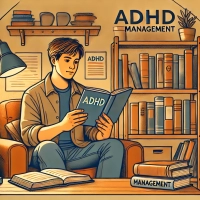How to Address ADHD: A Psychological Approach

Attention Deficit Hyperactivity Disorder (ADHD) is a neurodevelopmental disorder characterized by persistent patterns of inattention, hyperactivity, and impulsivity. These symptoms can significantly impact an individual's daily life. Addressing ADHD effectively requires a comprehensive approach that includes medication, psychological support, and behavioral strategies.
Research indicates that genetics play a significant role in the development of ADHD. Studies have shown that ADHD tends to run in families, suggesting a hereditary component. For instance:
- Family Studies: Children with ADHD often have parents or siblings with the disorder, indicating a genetic link. According to the American Psychiatric Association, if a parent has ADHD, there is a 50% chance their child will also have it.
- Twin Studies: Identical twins are more likely to both have ADHD compared to fraternal twins, further supporting the genetic influence.
Specific genes involved in the dopamine system, which is responsible for regulating attention and behavior, have been implicated in ADHD. Variations in these genes can affect neurotransmitter levels, impacting brain function and leading to symptoms of ADHD.
Neurological Factors
Brain imaging studies have revealed differences in the structure and function of the brains of individuals with ADHD. Key findings include:
- Brain Structure: Individuals with ADHD often have smaller volumes in certain areas of the brain, such as the prefrontal cortex, which is involved in executive functions like decision-making, impulse control, and attention.
- Neurotransmitter Imbalance: ADHD is associated with imbalances in neurotransmitters, particularly dopamine and norepinephrine. These chemicals play a crucial role in transmitting signals between nerve cells and regulating mood, attention, and behavior.
Environmental Factors
Several environmental factors during prenatal development and early childhood can contribute to the risk of developing ADHD. These include:
- Prenatal Exposure: Exposure to substances such as tobacco, alcohol, and drugs during pregnancy can increase the risk of ADHD in children. Maternal smoking and alcohol use have been particularly linked to the development of ADHD symptoms.
- Birth Complications: Premature birth, low birth weight, and complications during delivery can affect brain development and are associated with an increased risk of ADHD.
- Lead Exposure: Early exposure to lead, a neurotoxin, has been linked to the development of ADHD. Children living in environments with high levels of lead contamination are at greater risk.
Psychological and Social Factors
While not direct causes, certain psychological and social factors can exacerbate ADHD symptoms or increase the likelihood of their development. These include:
- Family Stress: High levels of stress and conflict within the family can contribute to the severity of ADHD symptoms. Inconsistent parenting practices and lack of structure can also play a role.
- Traumatic Experiences: Exposure to traumatic events or chronic stress during childhood can impact brain development and increase the risk of ADHD.
Symptoms of ADHD
Attention Deficit Hyperactivity Disorder (ADHD) manifests through a range of symptoms that can vary in severity and impact daily functioning. These symptoms are generally categorized into two main types: inattentive and hyperactive-impulsive. Some individuals predominantly exhibit symptoms from one category, while others display a combination of both.
Inattentive Symptoms
Individuals with inattentive ADHD may struggle with maintaining focus and organization. Common inattentive symptoms include:
- Difficulty Sustaining Attention: Trouble focusing on tasks or activities, especially those that are monotonous or require prolonged concentration.
- Careless Mistakes: Frequent mistakes in work or school activities due to inattention to details.
- Listening Challenges: Appearing not to listen when spoken to directly, even when there is no obvious distraction.
- Following Instructions: Difficulty following through on instructions and completing tasks, often moving from one incomplete task to another.
- Organizational Issues: Poor organizational skills, leading to disorganized work and difficulty managing time effectively.
- Avoiding Mental Effort: Avoidance of tasks that require sustained mental effort, such as homework or lengthy projects.
- Losing Items: Frequently losing items necessary for tasks and activities, such as keys, books, or tools.
- Easily Distracted: Being easily distracted by extraneous stimuli, often interrupting tasks and activities.
- Forgetfulness: Forgetting daily activities, appointments, and responsibilities.
Hyperactive-Impulsive Symptoms
Hyperactive-impulsive symptoms are characterized by excessive activity and impulsive behaviors that are inappropriate for the setting. These symptoms include:
- Fidgeting and Squirming: Inability to stay still, often fidgeting with hands or feet or squirming in the seat.
- Leaving Seat Frequently: Leaving seat in situations where remaining seated is expected, such as in a classroom or office.
- Running or Climbing Inappropriately: In children, excessive running or climbing in situations where it is inappropriate; in adults, this may manifest as restlessness.
- Difficulty Playing Quietly: Inability to engage in quiet play or leisure activities.
- Being "On the Go": Acting as if driven by a motor, often unable to stay still for extended periods.
- Excessive Talking: Talking excessively, often interrupting or intruding on others' conversations.
- Blurting Out Answers: Answering questions before they have been fully asked or finishing others' sentences.
- Difficulty Waiting Turn: Difficulty waiting for their turn in situations such as lines or games.
- Interrupting or Intruding: Frequently interrupting or intruding on others, such as butting into conversations or games .
Additional Symptoms in Adults
While ADHD is often diagnosed in childhood, many individuals continue to experience symptoms into adulthood. Adult ADHD symptoms can include:
- Time Management Issues: Chronic lateness and difficulty managing time effectively.
- Impulsiveness: Making hasty decisions without considering consequences, which can affect relationships and career.
- Emotional Instability: Difficulty managing emotions, leading to frequent mood swings, frustration, and irritability.
- Poor Stress Management: Trouble coping with stress, often feeling overwhelmed by daily demands.
- Relationship Problems: Struggles with maintaining relationships due to inattentiveness, forgetfulness, and impulsive behaviors.
Do you often find it difficult to concentrate on tasks, even those that interest you?
- This question helps assess current issues with attention.
As a child, did you frequently get distracted during school lessons or homework?
- This question explores historical issues with attention.
Do you tend to forget daily tasks or appointments frequently?
- This question gauges present-day forgetfulness, a common symptom of ADHD.
Were there instances in your childhood when you forgot important events or meetings, causing problems?
- This question assesses past experiences with forgetfulness.
Do you often feel restless or find it hard to stay seated for extended periods?
- This question identifies current hyperactivity and restlessness.
Did you frequently leave your seat in class or at home when you were expected to remain seated?
- This question explores past hyperactivity behaviors.
Do you find yourself interrupting others during conversations or activities?
- This question helps assess impulsivity in social interactions.
Were you often reprimanded for interrupting others or speaking out of turn as a child?
- This question looks into past impulsivity.
Do you struggle with organizing tasks or managing time effectively in your daily life?
- This question evaluates current organizational skills and time management.
Did you have difficulty keeping your schoolwork or personal items organized during your school years?
- This question explores historical challenges with organization.
These questions can help determine the presence and severity of ADHD symptoms both in the past and present, providing a comprehensive view of the individual's experiences and challenges.
Managing ADHD
1. Medication Therapy
Medications are one of the most effective treatments for ADHD. There are two main types of medications:
- Stimulants (e.g., methylphenidate and amphetamines): These drugs help improve attention and reduce hyperactivity and impulsivity. They are considered the first-line treatment for ADHD.
- Non-stimulants (e.g., atomoxetine): These medications are useful for individuals who experience side effects from stimulants or do not respond well to them.
2. Psychotherapy
Psychotherapy plays a crucial role in ADHD treatment, helping individuals develop the skills needed to manage symptoms and improve their quality of life.
- Cognitive Behavioral Therapy (CBT): CBT is effective for individuals with ADHD as it helps them identify and change negative thought patterns and behaviors. It focuses on improving time management, organizational skills, and impulse control.
- Behavioral Therapy: This therapy is particularly effective for children with ADHD. It involves creating structured routines and positive reinforcement to encourage desirable behaviors and reduce disruptive ones.
- Family Therapy: ADHD can affect family dynamics. Family therapy helps family members understand the disorder, improve communication, and develop strategies to support the individual with ADHD.
3. Lifestyle and Behavioral Strategies
In addition to therapy and medication, certain lifestyle changes and behavioral strategies can help manage ADHD symptoms.
- Structured Routine: Establishing a consistent daily routine helps individuals with ADHD stay organized and reduce feelings of overwhelm.
- Healthy Diet and Exercise: Regular physical activity and a balanced diet can positively impact ADHD symptoms by improving mood, attention, and overall health.
- Mindfulness and Relaxation Techniques: Practices such as mindfulness meditation and yoga can help individuals with ADHD improve focus and reduce stress.
4. Educational Support
For children and adolescents, support in educational settings is essential. This may include:
- Individualized Education Plans (IEPs): Tailored educational plans that provide accommodations and modifications to support the learning needs of students with ADHD.
- Classroom Strategies: Teachers can implement strategies such as breaking tasks into smaller steps, providing clear instructions, and using visual aids to help students with ADHD stay focused and organized.
5. Professional Guidance
Seeking help from healthcare professionals who specialize in ADHD is crucial. They can provide comprehensive assessments, recommend appropriate treatments, and monitor progress.
Practical Examples
Managing ADHD effectively involves implementing various strategies that can help individuals improve their daily functioning and overall quality of life. Here are some practical examples that illustrate how different approaches can be applied:
Example 1: Using Organizational Tools
Situation: John, a college student with ADHD, often forgets to complete assignments and loses track of deadlines.
Strategy: John starts using a digital planner app that allows him to set reminders and deadlines for his assignments. He also uses color-coded folders and labels to keep his study materials organized.
Outcome: By using these organizational tools, John significantly improves his ability to manage his time and keep track of his assignments, resulting in better academic performance.
Example 2: Implementing a Structured Routine
Situation: Emily, a working professional with ADHD, struggles with maintaining focus and productivity throughout the day.
Strategy: Emily establishes a structured daily routine, including specific times for work, breaks, and leisure activities. She sets a timer for work intervals (Pomodoro technique) to maintain focus and uses a whiteboard to list her daily tasks.
Outcome: With a structured routine and clear goals for each day, Emily finds it easier to stay focused and productive, reducing her feelings of overwhelm and stress.
Example 3: Utilizing Behavioral Therapy
Situation: Tom, a 10-year-old boy with ADHD, has difficulty following instructions and often interrupts his classmates.
Strategy: Tom's parents enroll him in behavioral therapy, where he learns techniques for self-control and positive reinforcement. His therapist works with him on setting small, achievable goals and rewards him for good behavior.
Outcome: Over time, Tom develops better self-control and learns to follow instructions more consistently. His behavior improves both at home and in school, leading to more positive interactions with his peers and teachers.
Example 4: Incorporating Mindfulness Practices
Situation: Sarah, an adult with ADHD, experiences high levels of stress and anxiety, which exacerbate her symptoms.
Strategy: Sarah starts practicing mindfulness meditation for 10 minutes each morning and evening. She also incorporates deep breathing exercises during stressful moments throughout the day.
Outcome: Mindfulness practices help Sarah reduce her stress and improve her focus. She feels more in control of her emotions and better equipped to handle daily challenges.
Example 5: Seeking Professional Support
Situation: Mike, a teenager with ADHD, feels overwhelmed by his academic workload and struggles to keep up with his peers.
Strategy: Mike's parents arrange for him to meet with a school counselor who specializes in ADHD. The counselor helps Mike develop study strategies tailored to his learning style and provides emotional support.
Outcome: With the counselor's guidance, Mike learns effective study techniques and gains confidence in his abilities. His academic performance improves, and he feels more positive about his school experience.
Example 6: Adapting the Environment
Situation: Lisa, a graphic designer with ADHD, finds it challenging to work in a noisy, cluttered office.
Strategy: Lisa rearranges her workspace to minimize distractions, using noise-canceling headphones and organizing her desk to keep it clutter-free. She also sets boundaries with her colleagues to reduce interruptions.
Outcome: By creating a more conducive work environment, Lisa can focus better and increase her productivity, leading to higher job satisfaction and performance.
Here are ten unique self-help strategies for managing ADHD symptoms. These approaches can be integrated into daily routines to help improve focus, organization, and overall well-being.
1. Create a Distraction-Free Workspace
- Step-by-Step:
- Identify a quiet area in your home or office.
- Remove unnecessary items and clutter from the workspace.
- Use noise-canceling headphones or soft background music to block out distractions.
- Keep essential tools and materials within easy reach.
2. Set Specific Goals
- Step-by-Step:
- Break larger tasks into smaller, manageable steps.
- Set clear, achievable goals for each step.
- Use a goal-tracking app or journal to monitor progress.
- Celebrate small achievements to stay motivated.
3. Practice Mindfulness Meditation
- Step-by-Step:
- Find a quiet, comfortable place to sit or lie down.
- Close your eyes and take deep breaths, focusing on your breath.
- If your mind wanders, gently bring your focus back to your breath.
- Start with 5 minutes a day and gradually increase the duration.
4. Use Visual Aids
- Step-by-Step:
- Create visual schedules using calendars, planners, or whiteboards.
- Use color-coding to differentiate between tasks and priorities.
- Place reminders and notes in visible areas, such as your desk or refrigerator.
5. Limit Screen Time
- Step-by-Step:
- Set specific times for using electronic devices.
- Use apps or built-in settings to limit screen time.
- Take regular breaks to rest your eyes and mind.
- Engage in offline activities, such as reading or outdoor exercise, during breaks.
6. Develop a Sleep Routine
- Step-by-Step:
- Set a consistent bedtime and wake-up time.
- Create a relaxing pre-sleep routine, such as reading or taking a warm bath.
- Avoid caffeine and electronic devices before bed.
- Make your sleep environment comfortable and free from distractions.
7. Exercise Regularly
- Step-by-Step:
- Choose physical activities you enjoy, such as walking, cycling, or swimming.
- Schedule regular exercise sessions, aiming for at least 30 minutes a day.
- Combine exercise with social activities, like joining a sports team or walking with a friend.
- Use exercise as a way to take breaks and recharge during work or study sessions.
8. Practice Deep Breathing Techniques
- Step-by-Step:
- Sit or lie down in a comfortable position.
- Inhale deeply through your nose for a count of four.
- Hold your breath for a count of four.
- Exhale slowly through your mouth for a count of four.
- Repeat for several minutes, focusing on the breath.
9. Seek Social Support
- Step-by-Step:
- Join a support group for individuals with ADHD.
- Share your experiences and challenges with family and friends.
- Build a network of supportive people who understand your situation.
- Attend workshops or seminars on ADHD management.
10. Use Time Management Tools
- Step-by-Step:
- Use timers or alarms to stay on schedule.
- Break tasks into timed intervals using the Pomodoro technique.
- Prioritize tasks using to-do lists or task management apps.
- Set deadlines for each task and hold yourself accountable.
Preparatory Steps for Managing ADHD
Before diving into self-help strategies, it’s important to prepare effectively. Here are seven steps to get started:
1. Acknowledge the Problem
- Accept that ADHD is a part of your life and that addressing it is crucial for your well-being.
2. Educate Yourself
- Learn about ADHD from reliable sources to understand its symptoms, causes, and treatment options.
3. Seek Professional Diagnosis
- Consult with a healthcare professional to get a proper diagnosis and discuss potential treatment plans.
4. Set Realistic Expectations
- Understand that managing ADHD is a continuous process and that progress may be gradual.
5. Identify Your Triggers
- Reflect on situations or activities that exacerbate your symptoms and think of ways to minimize their impact.
6. Create a Support System
- Inform close family and friends about your condition and seek their support and understanding.
7. Plan Your Approach
- Develop a structured plan that includes a combination of self-help strategies, professional treatments, and lifestyle changes tailored to your needs.
By following these steps and implementing self-help strategies, individuals with ADHD can improve their daily functioning and overall quality of life.
ADHD is one of the most common neurodevelopmental disorders in children. According to the Centers for Disease Control and Prevention (CDC), approximately 6.1 million children in the United States have been diagnosed with ADHD. This represents about 9.4% of children aged 2-17 years.
ADHD can persist into adulthood. Although ADHD is often diagnosed in childhood, it is estimated that about 60% of those diagnosed as children will continue to experience symptoms into adulthood. This means that millions of adults also struggle with ADHD, affecting their personal and professional lives.
Genetics play a significant role in ADHD. Studies have shown that if a parent has ADHD, there is a 50% chance that their child will also have the disorder. Twin studies have further supported the genetic link, indicating a high heritability factor.
Environmental factors can influence ADHD symptoms. Prenatal exposure to tobacco, alcohol, and drugs, as well as lead exposure during early childhood, have been linked to an increased risk of developing ADHD. Birth complications and low birth weight are also associated with higher ADHD risk.
ADHD is often accompanied by other conditions. Individuals with ADHD frequently experience comorbid conditions such as anxiety disorders, depression, learning disabilities, and oppositional defiant disorder (ODD). This can complicate diagnosis and treatment, requiring a comprehensive approach to care.
Early intervention can make a significant difference. Early diagnosis and treatment of ADHD can help improve outcomes for children, reducing the impact on their academic, social, and emotional development. Behavioral therapy, educational support, and medication are commonly used to manage symptoms).
ADHD is diagnosed more frequently in boys than in girls. Boys are about three times more likely to be diagnosed with ADHD than girls. However, ADHD in girls is often underdiagnosed because they tend to exhibit less hyperactivity and more inattentiveness, which can be overlooked.
Lifestyle changes can help manage ADHD symptoms. Regular physical activity, a healthy diet, structured routines, and mindfulness practices can all contribute to better management of ADHD symptoms. These lifestyle interventions can complement medical and psychological treatments.
ADHD awareness is growing. Public awareness and understanding of ADHD have increased significantly in recent years, leading to better support and resources for individuals with the disorder. Organizations like CHADD (Children and Adults with Attention-Deficit/Hyperactivity Disorder) provide valuable information and advocacy.
Technology offers new tools for managing ADHD. From digital planners and reminder apps to online therapy platforms, technology provides innovative solutions to help individuals with ADHD stay organized, focused, and connected with support networks.
Professional Advice and When to Seek Help
Managing ADHD effectively often requires the involvement of healthcare professionals. Here are some guidelines on when and how to seek professional help, along with recommendations on useful types of therapy and interventions.
When to Seek Professional Help
It is crucial to seek professional help if you or a loved one experiences the following:
Persistent Symptoms:
- If ADHD symptoms such as inattention, hyperactivity, and impulsivity persist despite trying self-help strategies.
Impact on Daily Life:
- When symptoms significantly impact daily functioning, including work, school, relationships, and personal well-being.
Emotional Difficulties:
- Experiencing frequent feelings of frustration, sadness, anxiety, or low self-esteem due to ADHD symptoms.
Behavioral Issues:
- Persistent behavioral problems such as frequent outbursts, inability to follow rules, or difficulty interacting socially.
Struggles with Medication:
- If current medications are not effective or cause intolerable side effects.
Complex Situations:
- When ADHD is accompanied by other mental health conditions such as depression, anxiety, or learning disabilities.
How to Seek Professional Help
Primary Care Physician:
- Start with a visit to your primary care doctor, who can provide an initial assessment and refer you to a specialist if necessary.
Psychiatrist:
- A psychiatrist can diagnose ADHD, prescribe medications, and monitor their effectiveness and side effects.
Psychologist:
- Psychologists provide therapy and behavioral interventions to help manage ADHD symptoms. They may also conduct assessments to confirm a diagnosis.
Neurologist:
- In complex cases, a neurologist might be consulted to rule out other neurological conditions that could mimic ADHD symptoms.
Educational Psychologist:
- For children, an educational psychologist can assess learning difficulties and recommend accommodations and support in the school environment.
ADHD Specialists:
- Seek out professionals who specialize in ADHD for a more tailored approach to diagnosis and treatment.
Types of Therapy and Interventions
Cognitive Behavioral Therapy (CBT):
- CBT helps individuals with ADHD develop coping strategies, improve time management, and address negative thought patterns that exacerbate symptoms.
Behavioral Therapy:
- Particularly effective for children, this therapy involves creating structured routines and positive reinforcement to encourage desired behaviors.
Psychoeducation:
- Educating individuals and families about ADHD to foster understanding and effective management of the condition.
Social Skills Training:
- Helps individuals with ADHD improve their social interactions and communication skills.
Parent Training and Family Therapy:
- Equips parents with strategies to support their child with ADHD, creating a supportive home environment. Family therapy can address any family dynamics that may be affected by ADHD.
Medication Management:
- Regular consultations with a psychiatrist or physician to adjust medications as needed, ensuring optimal efficacy and minimal side effects.
Occupational Therapy:
- Helps individuals develop practical skills to manage daily tasks and improve organizational abilities.
Mindfulness-Based Cognitive Therapy (MBCT):
- Combines mindfulness practices with cognitive therapy to help individuals stay present and reduce impulsive behaviors.
Conclusion
ADHD may present challenges, but it also opens the door to discovering unique strengths and potential. Embrace your journey with optimism and determination. Each step you take towards managing ADHD is a testament to your resilience and commitment to personal growth. With the right tools, support, and mindset, you can overcome the hurdles of ADHD and achieve your goals.
You are not alone in this journey. Millions of people around the world share similar experiences and have found ways to thrive. Draw inspiration from their stories and know that with perseverance, you too can create a path to success and well-being. Believe in yourself, seek the support you need, and keep moving forward. Your potential is limitless, and every effort you make brings you closer to unlocking it.
"Driven to Distraction: Recognizing and Coping with Attention Deficit Disorder from Childhood Through Adulthood" by Edward M. Hallowell and John J. Ratey
- This book provides an in-depth look at ADHD and offers practical advice for managing the condition.
"Taking Charge of ADHD: The Complete, Authoritative Guide for Parents" by Russell A. Barkley
- A comprehensive guide for parents to understand and manage their child's ADHD effectively.
"The ADHD Advantage: What You Thought Was a Diagnosis May Be Your Greatest Strength" by Dale Archer
- This book explores the positive aspects of ADHD and how to harness its potential.
"Women with Attention Deficit Disorder: Embrace Your Differences and Transform Your Life" by Sari Solden
- A valuable resource specifically for women with ADHD, offering insights and strategies for thriving.
"ADHD: A Handbook for Diagnosis and Treatment" by Russell A. Barkley
- A detailed handbook covering the diagnosis and treatment of ADHD in both children and adults.
"More Attention, Less Deficit: Success Strategies for Adults with ADHD" by Ari Tuckman
- Practical strategies and advice tailored for adults living with ADHD.
"Scattered Minds: The Origins and Healing of Attention Deficit Disorder" by Gabor Maté
- Dr. Gabor Maté explores the root causes of ADHD and offers a compassionate approach to healing.
"Delivered from Distraction: Getting the Most out of Life with Attention Deficit Disorder" by Edward M. Hallowell and John J. Ratey
- A follow-up to "Driven to Distraction," this book provides further insights and strategies for living with ADHD.
"The ADHD Workbook for Teens: Activities to Help You Gain Motivation and Confidence" by Lara Honos-Webb
- An interactive workbook designed to help teenagers manage their ADHD symptoms and build confidence.
"Mindfulness for Teen ADHD: A Workbook for Improving Focus and Finding Calm" by Debra Burdick
- This workbook integrates mindfulness practices to help teens with ADHD improve focus and reduce stress.
- Video response to the topic: How to Address ADHD: A Psychological Approach
While self-care strategies are valuable for managing symptoms related to psychological issues, they are not a substitute for professional treatment. It's important to recognize that self-care complements but does not replace the expert guidance and personalized therapy provided by qualified mental health professionals. Engaging in self-care is beneficial for general well-being and can be part of a broader treatment plan, but it's crucial to consult with a healthcare provider to ensure that you are receiving comprehensive care, especially for complex psychological conditions. This approach ensures that any underlying issues are properly addressed, potentially enhancing the effectiveness of self-care practices.









